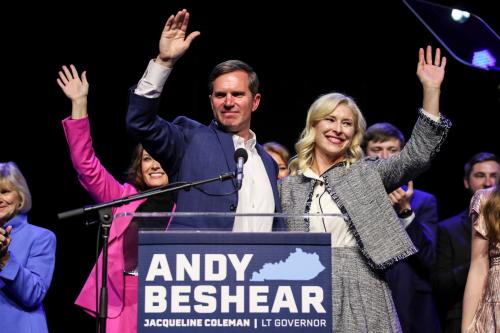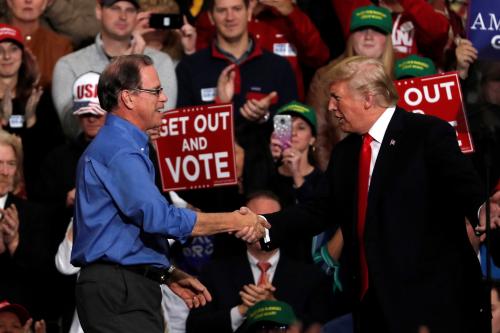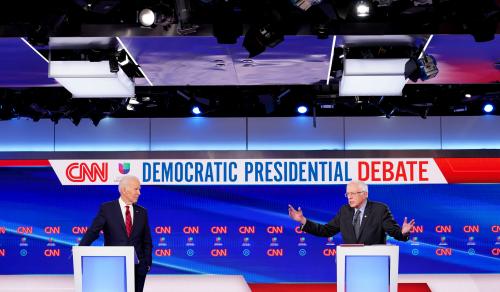On the night the 2020 Democratic National Convention kicked off, Democrats welcomed Republican speakers to the stage in an effort to lure GOP voters to cross the aisle in November. While crossover speakers at party conventions are quite common, Monday night’s Republican lineup—John Kasich, Susan Molinari, Meg Whitman and Christine Todd Whitman—was designed to show off the Democrats’ big-tent strategy. In addition to the Republicans were Senator Bernie Sanders, Michelle Obama, New York Governor Andrew Cuomo, and Nevada Senator Catherine Cortez Masto. On Monday night the Biden campaign was trying to signal that all are welcome into the Democratic fold, and that opposition to Donald Trump does not mean their decision should be to stay home.
Will it work?
In any presidential election, there are voters who cross party lines. As the parties have become polarized and party affiliation and ideology have become largely synonymous, crossover voting in presidential elections has become much less frequent. For comparison, CNN’s 2016 exit polls show that only 8% of Democrats voted for Donald Trump and 8% of Republicans voted for Hillary Clinton.
Despite Mr. Trump’s insistence that his support within the Republican Party is 96%, that claim is simply not true. Past polling has shown that there are a small percentage of people who continue to identify as Republicans who disapprove of President Trump, but that the number may be higher this year. Between June and August, surveys from The Economist/YouGov in the first week of each month showed Republicans’ approval hovering around 85%, with Republicans’ disapproval between 14-15%.
There is some ground for Mr. Biden to take a larger percentage of Republicans in 2020 than Hillary Clinton did in 2016. Yet, it is hard to imagine that Monday night’s speakers will do the trick and move voters who are on the fence. One of those speakers is a former Ohio governor and another is a former New York congresswoman who hasn’t served in the House since the mid-1990s. Republicans likely have a firm idea of whether they support or oppose President Trump, and a Republican endorsement of Biden likely will not affect that decision. At the same time, President Trump has easy ammunition to criticize Monday night’s speakers, claiming that John Kasich—who Mr. Trump beat in the 2016 presidential primary—and Meg Whitman—who endorsed Hillary Clinton in 2016—are not real Republicans.
Another group of voters getting attention from media—beyond Republicans looking to vote across party lines—are former Republicans who now identify as independents or as Democrats. Those former Republicans surely exist, including media personalities like MSNBC’s Joe Scarborough (who has renounced his GOP affiliation) and the Republicans who started the TV-savvy, anti-Trump political action committee The Lincoln Project. Yet, Gallup polling shows that the percentage of the public that self-identifies as a Republican has held stable since Donald Trump was elected president. That number was 28% both in December 2016 and July 2020, and thus, former Republicans are few in number.
For both groups—former Republicans and Republicans who oppose the president—their choice is not between Donald Trump and Joe Biden. Their choice is between Joe Biden and staying home. These voters know who Donald Trump is, and they don’t care for what they see. These voters want to hear better policies, ideas, and vision. They also want to see in Mr. Biden a type of leadership they believe America should have, but they do not think America currently has. They know they will not agree with the former vice president on everything, but it is Mr. Biden who must convince him he is the safer bet.
And in fact, to convey that “safety,” another group of elected officials may actually play an even stronger role in demonstrating to Republicans and former Republicans why Joe Biden is a safe bet: moderate Democrats. Democrats like Senators Joe Manchin (W.Va.) and Doug Jones (Ala.) [who spoke Monday night] and Reps. Collin Peterson (Minn.) and Joe Cunningham (S.C.) can present themselves as moderate legislators who will not give Joe Biden a blank check to implement ultra-liberal policies. Even though John Kasich noted that many Republicans may not have imagined voting for Joe Biden and went on to say, “I don’t believe Joe will turn sharp left,” that message would be better received from other sources than a man who came up short in a primary against the president.
Appealing to moderate voters (a group that can include Republicans and former Republicans) is essential for Mr. Biden’s success, but it is part of a difficult balancing act that the Democratic ticket must undertake. Progressives do not want to hear from an anti-abortion, union-busting conservative governor from Ohio. Republicans don’t want to hear from a self-proclaimed socialist who supports Medicare-For-All and the Green New Deal. It is incumbent on the nominee to give both of those groups a reason to see in him the better path forward, but there may be limits to what even Mr. Biden can accomplish on this front.
In an already abbreviated party convention, Democrats have precious time to fix some of the divisions that exist within their party, generate enthusiasm in the base, and communicate to independents that they are more than just “Not Donald Trump,” but a party of ideas that they can support. And for Trump-skeptical Republicans and former Republicans, they see a three-way race among a tax-and-spend liberal, a print-and-spend conservative, and the decision to stay home. John Kasich speaking on the DNC stage Monday night may not switch many voters. Instead, Donald Trump is the Republican with the greatest capacity to push Biden-curious Republicans to go to the polls and vote Democratic.
The Brookings Institution is committed to quality, independence, and impact.
We are supported by a diverse array of funders. In line with our values and policies, each Brookings publication represents the sole views of its author(s).








Commentary
Kasich can’t help Biden win over Republicans but Trump can
August 17, 2020